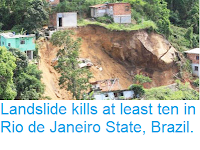At least twenty four people have died in a series of landslips in the Brazilian states of São Paulo and Rio de Janeiro on Tuesday 3 March 2020. The incidents were triggered by a large storm hitting the coastal areas of the two states, brining with it 280 mm of rain in just 12 hours. Landslides are a common problem after severe weather events, as excess
pore water pressure can overcome cohesion in soil and sediments,
allowing them to flow like liquids. Approximately 90% of all landslides
are caused by heavy rainfall. As well as the known fatalities at least 30 people are missing and several hundred have been displaced from their homes, making it likely that the number of fatalities will rise. The majority of the deaths occurred in São Paulo State, where nineteen people have died, including a mother and her child who became trapped beneath the rubble of their home following a landslide, and two firefighters who were killed when a second landslip hit the same area as they were trying to rescue them. A further five fatalities have been recorded in Rio de Janeiro State.
House displaced from its foundations by a landslide in the municipality of Guarujá in São Paulo State, Brazil, on 3 March 2020. AFP/Getty Images.
Southern Brazil has a rainy season that lasts from Ocotober to March,
with peak rains from mid-November to mid-January, however, this year's
rains have been exceptionally strong. Brazil has suffered a string of
flood-related disasters in recent years,
most notably in 2011, when over 800 people died. The country has a
rapidly growing population, with little effective urban planning, which
has led to sprawling urban developments springing up with little thought
to natural hazards, and in particular poorer neighborhoods often
expanding up unstable hillsides, with the result that when floods occur
(which is not unusual) communities are often quickly overwhelmed. This
years exceptional rains have led to more widespread flooding, which may
also persist for longer, and there is a distinct danger that without
determined action the death toll may exceed that of 2011.
The aftermath of a landslide in the Baixada Santista Metropolitan Area of São Paulo State, Brazil, on 3 March 2020. São Paulo Civil Defense.
This extreme weather may be linked to an El Niño wearther system over the Pacific Ocean. The
El Niño is the warm phase of a long-term climatic oscillation affecting
the southern Pacific, which can influence the climate around the world.
The onset of El Niño conditions is marked by a sharp rise in
temperature and pressure over the southern Indian Ocean, which then
moves eastward over the southern Pacific. This pulls rainfall with it,
leading to higher rainfall over the Pacific and lower rainfall over
South Asia. This reduced rainfall during the already hot and dry summer
leads to soaring temperatures in southern Asia, followed by a rise in
rainfall that often causes flooding in the Americas and sometimes
Africa. Worryingly climatic predictions for the next century suggest
that global warming could lead to more frequent and severe El Niño
conditions, extreme weather conditions a common occurrence.
Movements of air masses and changes in precipitation in an El Niño weather system. Fiona Martin/NOAA.
See also...
Follow Sciency Thoughts on Facebook.









